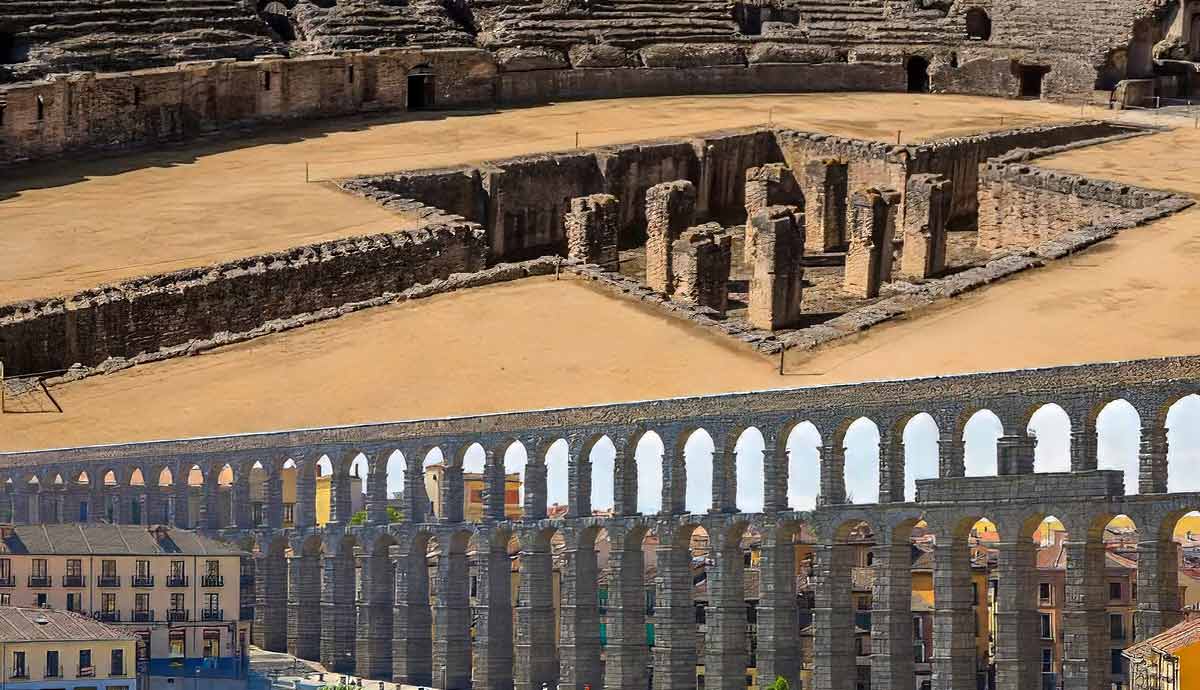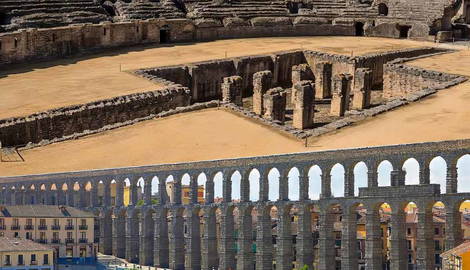
The end of the Second Punic War in the late 3rd century BCE sparked the beginning of Iberia’s romanization. Roads soon criss-crossed the peninsula, and port cities became the outlet for a wide range of goods, including precious metals and Roman foods like the fermented condiment, garum. Two millennia later, monuments from Roman Spain litter the country. From the Vitruvian perfection of the Aqueduct of Segovia to the imposing cultural statement of Mérida’s Roman Theatre, we’ll look at some of the highlights.
1. The Walls of Lugo

In Galicia in the far northwest of Spain, Lugo is a patch of Hispania that was difficult to tame. Julius Caesar campaigned against the Callaeci people as governor here in 62 BCE. He returned to Rome claiming that the conquest of the peninsula was complete, but the fight in northern Spain continued for another 20 years. Even today, Galicia has a distinct Celtic identity, shared with the likes of Brittany and Ireland.
In the 3rd century CE, Lucus Augusti was a seat of government in a gold mining region. At that time, centuries after the conquest of Hispania, there was still a threat from barbarians and local chiefs. The threat was deemed severe enough that the city was wrapped in almost 7,000 feet of forbidding walls, clad with slate and granite. Today, there is no more complete example of military architecture anywhere in the former Western Roman Empire.
Rising to 50 feet, there are more than 80 towers, all intact. They were all built and configured with precision, to avoid any blind spots. A few mysteries swirl around this structure. One is why a key Roman-era residential area was left outside of the defenses. At the same time, a large area within the walls became empty land by the 3rd century.
The most authentic of the five original gates is the Porta Miñá on the west side. This opening retains 1,750-year-old details including its original round arches and barrel vault. The passage is barely wide enough for two people and it seems all the smaller for the two flanking towers that bulge out of it.
Four stairways and two ramps lead up to the battlements. From here it’s possible to survey a city that escaped the confines of the walls in the 19th century.
2. Tarragona

Tumbling down to the Mediterranean in Catalonia, Tarragona is a city with Roman history woven into its streetscape. Homes in the elevated old town are built into the ruins of 2,000-year-old Roman monuments. It is not unusual to spot spolia, reused building stone, complete with Roman inscriptions. They appear on the streets, inside businesses, or even within private residences.
Tarragona grew in importance from the 3rd century BCE. By the time Emperor Augustus stayed here in the late 1st century BCE, it was the capital of Tarraconensis. This province covered the bulk of the Iberian peninsula. Later, Emperor Galba (3 BCE – 69 CE) spent eight years in Tarraco as the Governor of Tarraconensis before his short reign as emperor.
The showpiece in Tarragona is the amphitheater from the second century CE. Built into the cliffs, it has a sweeping view of the Mediterranean from the highest part of its terraces. Up the slope is the Provincial Forum, ordered by Emperor Vespasian in 73 CE. Once the cultural and administrative heart of Tarraco, this complex covers the bulk of Tarragona’s Medieval old town.
Scattered here are chunks of the circus, which once seated 30,000 people. This is linked via an atmospheric barrel-vaulted passageway to the Praetorium, a tower that marks the corner of the once vast forum. Later this was adapted into a palace for the Medieval Crown of Aragon.
Much of the old town sits within a wall, the lower sections of which are Roman and go back to the 3rd century BCE. The wealth of Roman finds uncovered in Tarragona is on show at the National Archaeological Museum there. Short trips can also be made to a walkable Roman aqueduct, a quarry, and a preserved Roman villa with a spectacular early Christian dome fresco.
3. Mérida

Another capital, Augusta Emerita, once held sway over the Province of Lusitania. The city was founded by Augustus in 25 BCE and built from scratch as a home for retired (emeriti) veterans. They had fought a bloody campaign to subdue the defiant Celtic Cantabri people in the north of the country. Only then was the peninsula fully brought under the Roman yoke.
In modern-day Extremadura, Mérida has held onto a whole ensemble of monuments. This is one of the foremost archaeological complexes in the country. The starting point has to be the theater, one of the great Roman monuments outside Italy.
Theater performances were deemed immoral after the Christianization of the Roman Empire in the 4th century CE, and this building was gradually buried. After a time, only the concrete of the upper tiers, the summa cavea, could be seen.
The standout feature is the scaenae frons to the rear. Complete with frieze, cornice, and Corinthian capitals this ornately sculpted backdrop rises more than 50 feet.
The city’s amphitheater was abandoned around the same time, with upper terraces quarried for their stone. Still, the lower stands, or summa cavea, remained undisturbed until it was excavated in the early 20th century.
During the excavation, there were some extraordinary finds, including a large fragment of a fresco. This venatio (show-hunting) scene depicts a man fighting a lioness, and can be seen at Mérida’s National Museum of Roman Art.

Mérida also stands out for the amount of ancient infrastructure on show. The bridge on the Guadiana River was one of Augusta Emerita’s first projects. Like any bridge, it has been altered many times. Yet, the first few arches from the right bank of the river have required little intervention in 2,000 years.
Similarly, the Acueducto de los Milagros, survives with an intact section almost 2,800 feet long. To the modern eye, the brick arches and neatly finished stone lend it the appearance of a 19th-century railroad viaduct.
4. Tower of Hercules

Gold and other precious metals mined in Galicia were exported via the port of Brigantium. The metal trade was one of the things that brought Julius Caesar here in the early 60s BCE.
With the conquest of northern Spain came a rush of Roman coastal settlements. By the 1st century CE there was a string of ports on the Bay of Biscay, easing navigation along the Atlantic Route. At this point a sophisticated supply and trade network extended from the Roman Mediterranean, via the Strait of Gibraltar to London and along the Rhine. Testifying to seaborne trade in Roman Galicia is a majestic, intact lighthouse that can be traced back to the 1st century CE.
The city of A Coruña, then Brigantium, is at the western edge of the Bay of Biscay, along a hazardous stretch of coastline known as the Costa da Morte (Coast of Death). At the tip of a peninsula jutting out into the Atlantic, the Tower of Hercules was considered by the Romans to be close to the edge of the world, the Finisterra.
Some 2,000 years after it was built on this dramatic promontory, the Tower of Hercules continues to serve as a navigation aid. This makes it the oldest functioning lighthouse in the world, and the only lighthouse in service with Roman origins. Despite its great age, it is also the third-tallest lighthouse in Spain, at 180 feet.
The lighthouse may have lost its navigational purpose in the Middle Ages when it became a fortification. The structure standing today dates to a Neoclassical restoration carried out in the late 18th century.
5. The Aqueduct of Segovia

No Roman structure in Spain makes an impact like the Aqueduct of Segovia, which once delivered water to the heart of this city from the turn of the 2nd century CE to the 19th century.
The most celebrated image of this famous aqueduct is in fact the final flourish of a structure more than ten miles in length. The aqueduct channeled water from a mountain spring along a sequence of less impressive conduits. This system included a cistern, a tower, and a carefully engineered 2,400-foot channel with a gradient of just a single percent. This section brought water to the Postigo, the rugged home to Segovia’s walled old city and Medieval stronghold, or Alcázar.
The city’s rocky topography helps to make the aqueduct’s bridge so spectacular. As from Postigo, the structure traverses Plaza del Azoguejo, Segovia’s former market square, reaching a height of almost 100 feet.
On its journey through the heart of Segovia, the aqueduct comprises almost 170 arches, configured on two levels. The majesty of the structure comes from its improbable narrowness, and its sheer height, casting long shadows over the open space below at dawn and sunset.
The main structure is more than 2,600 feet and consists of some 25,000 granite blocks quarried in the nearby Sierra de Guadarrama and carved into brick-like shapes. These are held together without the use of mortar.
7. Italica

Just outside of Seville, Italica is a city that thrived for some 400 years until the Guadalquivir River silted up and forced an abandonment. As Italica’s ruins were never built over, there’s a high state of preservation, especially when it comes to mosaics.
Italica goes back to the late 3rd century BCE towards the end of the Second Punic War 218-201 BCE), which was partly fought in Iberia. The city was founded as a colony for Italic veterans — that is, veterans from the Italian peninsula. Italica was smaller than Hispalis, modern-day Seville, but enjoyed hegemony over its near neighbor because of its distinguished origins and its location upstream on the Guadalquivir.
Among the important colonists in Italica was the illustrious gens Ulpia family, which produced a line of consuls and emperors. Two of them, Trajan and Emperor Hadrian, were born in Italica.
The joy of exploring Italica comes from the lower levels of once-lavish houses that belonged to the city’s elite. Signaling their high status are extended living areas, a prime location, and high-quality finishes. But most of all, their sense of luxury comes from the fine mosaics that lay hidden for more than 1,600 years.

The mosaics give the houses their names. For example, the House of the Planetarium has a mosaic with planetary divinities arranged in a circle to mark the days of the week, from the Moon (Monday) to the Sun (Sunday). Venus sits at the heart and represents Friday (diēs Veneris).
From Roman baths to a stately theater, Italica’s residents enjoyed amenities befitting the city’s lofty reputation. For instance, the amphitheater, built during Hadrian’s reign in the 2nd century CE, was one of the largest in ancient Rome. It had a capacity of 35,000, far exceeding the city’s population, which gives a hint of Italica’s elevated status. Tunnels lead through the stands of the Ima Cavea, the lowest tier that was reserved for the elite. Also visible is the arena’s subterranean service level, once concealed by wooden flooring.











